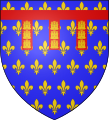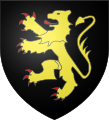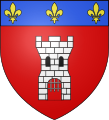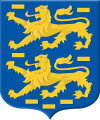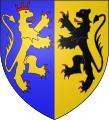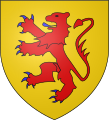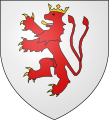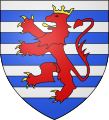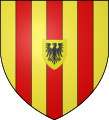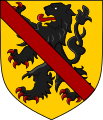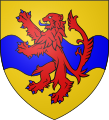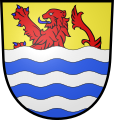المقاطعات السبعة عشر
المقاطعات السبعة عشر | |||||||||||
|---|---|---|---|---|---|---|---|---|---|---|---|
| 1549–1581 | |||||||||||
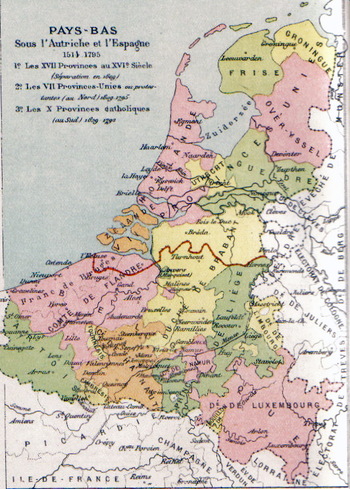 خريطة المقاطعات السبعة عشر، 1581 الانفصال موضّح بالخط الأحمر | |||||||||||
| المكانة | اتحاد شخصي لإقطاعات امبراطورية | ||||||||||
| العاصمة | بروكسل | ||||||||||
| اللغات الشائعة | الهولندية، Low Saxon, الفريزية ووالون واللوكسمبورگية والفرنسية | ||||||||||
| الدين | الكاثوليكية الپروتستانتية | ||||||||||
| الحكومة | ملكية | ||||||||||
| الحقبة التاريخية | الفترة الحديثة المبكرة | ||||||||||
| 1549 | |||||||||||
• قانون التبرؤ الهولندي | 1581 | ||||||||||
| |||||||||||
المقاطعات السبعة عشر Seventeen Provinces كان مصطلحاً يُطلق على ولايات امبراطورية في الأراضي الواطئة الهابسبورگية في القرنين 15 و 16. وكانوا يغطون تقريباً البلدان الواطئة، أي بلدان هولندا, بلجيكا ولوكسمبورگ الحالية، بالاضافة إلى معظم الأقاليم الفرنسية الحالية Nord بما فيها أرتوا، الفلاندرز الفرنسية وهينو الفرنسية. كما كان ضمن هذه المنطقة إقطاعات شبه مستقلة، أساساً الإقطاعات الكنسية، مثل لييج وكامبراي وستاڤلو-مالمدي.
نشأت المقاطعات السبعة عشر من الأراضي الواطئة البرگندية، وهي عدد من الاقطاعات التي كان يحتفظ بها بيت ڤالوا-برگندي وورثتهم أسرة هابسبورگ في 1482، ومنذ 1556 احتفظت بها إسپانيا الهابسبورگية. ومنذ 1512 شكلت المقاطعات الجزء الرئيسي في الدائرة البرگندية. وفي 1581 انفصلت المقاطعات المتحدة السبع ليشكلن الجمهورية الهولندية.
. . . . . . . . . . . . . . . . . . . . . . . . . . . . . . . . . . . . . . . . . . . . . . . . . . . . . . . . . . . . . . . . . . . . . . . . . . . . . . . . . . . . . . . . . . . . . . . . . . . . . . . . . . . . . . . . . . . . . . . . . . . . . . . . . . . . . . . . . . . . . . . . . . . . . . . . . . . . . . . . . . . . . . . .
التكوين
بعد أن استعاد الامبراطور الهابسبورگي شارل الخامس دوقية گلدرز من الدوق وليام من يوليش-كليڤ-برگ في معاهدة ڤنلو 1543، كانت المقاطعات السبعة عشر تتكون من:
- مقاطعة أرتوا
- مقاطعة فلاندرز، التي ضمت burgraviates of ليل، دواي، Orchies, the Lordship of Tournai and the Tournaisis
- لوردية مشلن
- مقاطعة نامور
- County of Hainaut
- مقاطعة زيلاند
- مقاطعة هولاند
- the Duchy of Brabant, including the Lordship of Breda, the Margraviate of Antwerp, the counties of Leuven and of بروكسل, and the advocacy of the Abbey of Nivelles and of Gembloux
- the Duchy of Limburg and the "Overmaas" lands of Brabant (دالهم، Valkenburg and Herzogenrath)
- مقاطعة لوكسمبورگ
- إمارة-أسقفية، ولاحقاً لوردية أوترخت
- لوردية فريزيا
- مقاطعة گلدرز
- Lordship of Groningen (بما فيها Ommelanden)
- لوردية درنته, Lingen, Wedde, and Westerwolde
- لوردية أوڤرإيسل
- مقاطعة زوتفن
ولم يكن دائماً نفس السبعة عشر مقاطعة ممثلين في مجلس أعيان الأراضي الواطئة. فأحياناً كان نواب مقاطعة موجوداً ضمن نواب مقاطعة أخرى.
In later years the County of Zutphen became a part of the دوقية گلدرز، and the Duchy of Limburg was dependent on the Duchy of Brabant. The Lordship of Drenthe is sometimes considered as part of the Lordship of Overijssel. On the other hand, the French-speaking cities of Flanders were sometimes recognised as a separate province.
Therefore, in some lists Zutphen and Drenthe are replaced by
- burgraviates of ليل، دواي، Orchies (also called Lilloise Flanders)
- Tournai and the Tournaisis
There were a number of fiefdoms in the Low Countries that were not part of the Seventeen Provinces, mainly because they did not belong to the Burgundian Circle but to the Lower Rhenish-Westphalian Circle. The largest of these was the Prince-Bishopric of Liège, the green area on the map, including the County of Horne. The ethnically and culturally Netherlandish duchies of Cleves and Julich did not join either. In the north, there were also a few smaller entities like the island of Ameland that would retain their own lords until the الثورة الفرنسية.
Historians came up with different variations of the list, but always with 17 members. This number could have been chosen because of its Christian connotation.[1][2][مطلوب توضيح]
التاريخ
تاريخ البلدان الواطئة
| |||||
|---|---|---|---|---|---|
أسقفية لييج 985–1790 |
هولندا البورگندية |
دوقية لوكسمبورگ اندمجت 1441 | |||
| 1384–1477 | |||||
هولندا الهابسبورگ 1477–1556 | |||||
البلاد الواطئة الاسبانية 1556–1581 | |||||
| هولندا الاسبانية |
هولندا المتحدة 1581–1795 |
1581–1713 | |||
هولندا النمساوية |
1713–1790 | ||||
الولايات المتحدة البلجيكية |
1790 | ||||
| أسقفية لييج 1790–1795 |
هولندا النمساوية |
1790–1794 | |||
الجمهورية الفرنسية |
الجمهورية الباتاڤية 1795–1806 |
1795–1804 | |||
الامبراطورية الفرنسية |
مملكة هولندا 1806–1810 |
1804–1815 | |||
المملكة المتحدة الهولندية 1815–1830 |
الدوقية الكبرى لوكسمبورگ | ||||
مملكة بلجيكا منذ 1830 |
مملكة هولندا منذ 1830 |
(في اتحاد شخصي مع هولندا حتى 1890) | |||
يعود أصل المقاطعات السبعة عشر إلى الأراضي الواطئة البرگندية. فقد كان دوقات برگندي يصبحون بشكل نظام لوردات لمختلف المقاطعات. ماري الأولى من ڤالوا، دوقة برگندي كانت آخر بيت برگندي.
وقد تزوجت ماري من ماكسيميليان الأول من هابسبورگ، الامبراطور الروماني المقدس في 1477، وأُلحِقت المقاطعات بـبيت هابسبورگ بوفاتها في 1482، باستثناء دوقية برگندي نفسها، التي، بفضل الشريعة السالية، استعادتها فرنسا بوفاة والد ماري، شارل الشجاع. حفيد ماكسيميليان، شارل الخامس من هابسبورگ، الامبراطور الروماني المقدس وملك إسپانيا، eventually united all seventeen provinces under his rule, the last one being the Duchy of Guelders, in 1543.
معظم تلك المقاطعات كانت إقطاعات في الامبراطورية الرومانية المقدسة. Two provinces, the County of Flanders and County of Artois, were originally French fiefs, but sovereignty was ceded to the Empire in the معاهدة كامبراي في 1529.
The Pragmatic Sanction of 1549 determined that the Provinces should remain united in the future and inherited by the same monarch. Therefore, Charles V introduced the title of Heer der Nederlanden ("Lord of the Netherlands"). Only he and his son could ever use this title.
After Charles V's abdication in 1555, his realms were divided between his son, Philip II of Habsburg, King of Spain, and his brother, Ferdinand I, Holy Roman Emperor. The Seventeen Provinces went to his son, the king of Spain.
النزاعات بين فيليپ الثاني ورعاياه الهولنديين أدت إلى حرب الثمانين عام، التي بدأت في 1568. وقد حصلت المقاطعات الشمالية السبع على استقلالهم كجمهورية تسمى المقاطعات المتحدة السبع. وقد ضموا:
- the Lordship of Groningen and of the Ommelanden
- the Lordship of Friesland
- the Lordship of Overijssel
- the Duchy of Guelders (except its upper quarter) and the County of Zutphen
- the Prince-Bishopric, later Lordship of Utrecht
- the County of Holland
- the County of Zeeland
The southern provinces, Flanders, Brabant, Namur, Hainaut, Luxembourg and the others, were restored to Spanish rule due to the military and political talent of the Duke of Parma, especially at the Siege of Antwerp (1584–1585). Hence, these provinces became known as the Spanish Netherlands or Southern Netherlands.
The northern Seven United Provinces kept parts of Limburg, Brabant, and Flanders during the Eighty Years' War (see Generality Lands), which ended with the Treaty of Westphalia in 1648.
Artois and parts of Flanders and Hainaut (French Flanders and French Hainaut) were ceded to France in the course of the 17th and 18th century.
الاقتصاد
By the mid-16th century, the Margraviate of Antwerp (Duchy of Brabant) had become the economic, political, and cultural center of the Netherlands after its capital had shifted from the nearby Lordship of Mechelen to the city of Brussels.
Bruges (County of Flanders) had already lost its prominent position as economic powerhouse of northern Europe. And Holland was gradually gaining importance in the 15th and 16th centuries.
However, after the revolt of the seven northern provinces (1568), the Sack of Antwerp (1576), the Fall of Antwerp (1584-1585), and the resulting closure of the Scheldt river to navigation, a large number of people from the southern provinces emigrated north to the new republic. The center of prosperity moved from cities in the south such as Bruges, Antwerp, Ghent, and Brussels to cities in the north, mostly Holland, including Amsterdam, لاهاي, and Rotterdam.
الأراضي الواطئة
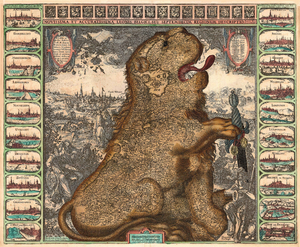
To distinguish between the older and larger Low Countries of the Netherlands from the current country of the Netherlands, Dutch speakers usually drop the plural for the latter. They speak of Nederland in singular for the current country and of de Nederlanden in plural for the integral domains of Charles V.
In other languages, this has not been adopted, though the larger area is sometimes known as the Low Countries in English.
The fact that the term Netherlands has such different historical meanings can sometimes lead to difficulties in expressing oneself correctly. For example, composers from the 16th century are often said to belong to the Dutch School (Nederlandse School). Although they themselves would not have objected to that term at that time, today it may wrongly create the impression that they were from the current Netherlands. In fact, they were almost exclusively from current Belgium.
. . . . . . . . . . . . . . . . . . . . . . . . . . . . . . . . . . . . . . . . . . . . . . . . . . . . . . . . . . . . . . . . . . . . . . . . . . . . . . . . . . . . . . . . . . . . . . . . . . . . . . . . . . . . . . . . . . . . . . . . . . . . . . . . . . . . . . . . . . . . . . . . . . . . . . . . . . . . . . . . . . . . . . . .
الفلاندرز
The same confusion exists around the word Flanders. Historically, it applied to the County of Flanders, corresponding roughly with the present day provinces of West Flanders and East Flanders. But when the Dutch-speaking population of Belgium sought more rights in the 19th century, the word Flanders was reused, but now to indicate the Dutch-speaking part of Belgium, of which the county of Flanders was just partly a part of (see Flemish Movement).
So the territory of the County of Flanders and present-day Flanders do not fully match:
- French Flanders belonged to the County of Flanders, but is today part of France.
- Zeelandic Flanders belonged to the County of Flanders, but is today part of the Netherlands.
- Tournai and the Tournaisis was some period considered as part of the County of Flanders, but is today part of Wallonia.
- The present-day Belgian province of Flemish Brabant belongs to present-day Flanders, but was part of the Duchy of Brabant.
- The present-day Belgian province of Antwerp belongs to present-day Flanders, but was part of the Duchy of Brabant.
- The present-day Belgian province of Limburg belongs to present-day Flanders, but was part of the Prince-Bishopric of Liège.
This explains for instance why the province of East Flanders is not situated in the east of present-day Flanders.
الدروع
II. Duchy of Brabant
III. Bishopric of Tournai
VI. Lordship of Groningen and of the Ommelanden
VII. Duchy of Guelders
VIII. County of Hainaut
XII. Lordship of Mechelen
XIII. County of Namur
XV. Prince-Bishopric, later Lordship of Utrecht
XVI. County of Zeeland
XVII. County of Zutphen
انظر أيضاً
- Governors of the Habsburg Netherlands
- The Netherlands (disambiguation)
- Burgundian Netherlands
- Greater Netherlands
- French Flemish
- Benelux
- Armorial of the leading Netherlands Nobles (in French)
الهامش
- ^ http://www.leidenuniv.nl/en/researcharchive/index.php3-c=297.htm The Invention of the Dutchman: the Dynamics of Identity in the Low Countries, 1400-1600; international colloquium, 2007 Leiden University
- ^ http://toastmastersd17.org/files/Properties-of-the-number-17.pdf
وصلات خارجية
- Pages using infobox country with unknown parameters
- جميع الصفحات التي تحتاج تنظيف
- مقالات بالمعرفة تحتاج توضيح from October 2009
- Articles with hatnote templates targeting a nonexistent page
- Seventeen Provinces
- مناطق تاريخية
- دول وأقاليم تأسست في 1482
- States and territories disestablished in 1581
- 16th-century establishments in the Habsburg Netherlands
- كيانات سابقة في هولندا
- تاريخ لوكسمبورگ
- ولايات الامبراطورية الرومانية المقدسة
- 1549 establishments in the Holy Roman Empire





